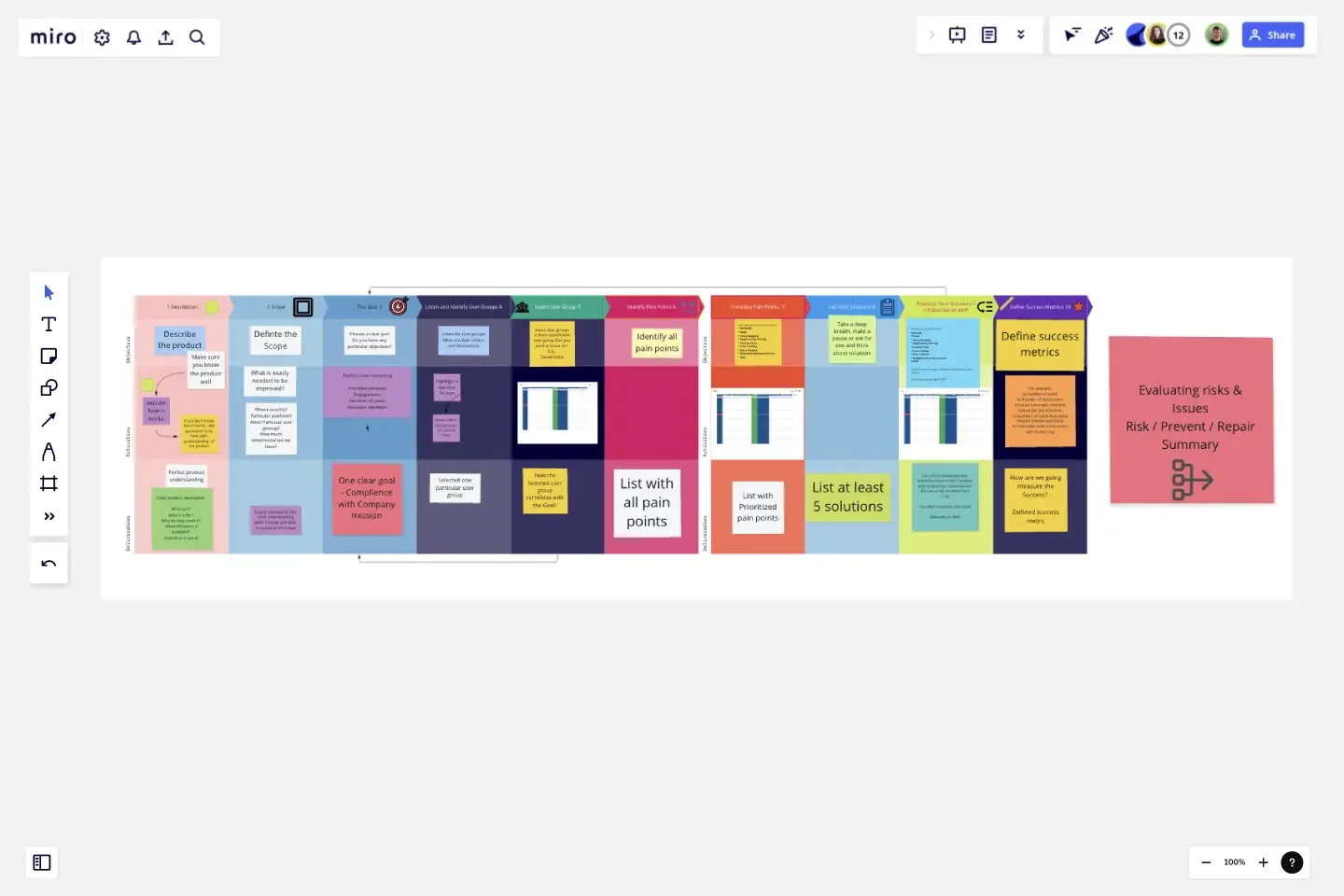Improve Any Product - Product Management
Enhance product quality and performance with Improve Any Product - Product Management template. Analyze feedback, prioritize enhancements, and drive improvement.
When to use The Improving any Product template?
As a leader or facilitator, you experience moments when you need to bring team members together, and Elaborate on:
Product description
the Scope of the Product
Set the Goal of current improvement
Listen and identify User groups. Think about how it correlates with your Goal or company's mission.
Select User Group
Identify pain points
Prioritize pain points
List your solutions
Prioritize your solutions. Think about how your solutions correlate with your Goal or company's mission. Elaborate on MVP.
Define the Success Metrics.
Improving any product works across multiple points:
The Scope. - It's important to set the frame and understand your scope from the beginning increasing your chances for Success.
Set clear goals.
Understand who is your user.
Painpoints - have a clear idea about the pain points of your customers.
So you can properly address them and list the solutions.
How to improve any product. There are specific steps:
Make a Product description
Define the Scope
Set the Goal
Listen and identify User groups. Think about how it correlates with your Goal or company's mission.
Select User Group
Identify pain points
Prioritize pain points
List your solutions
Prioritize your solutions. Think about how your solutions correlate with your Goal or company's mission. Elaborate on MVP.
Define the Success Metrics.
The last thing that I would recommend is to create a simple risk evaluation. - Define - Prevent - Repair.
This template was created by Mark V. Smetanin.
Get started with this template right now.
Remote Design Sprint Template
Works best for:
Design, Desk Research, Sprint Planning
A design sprint is an intensive process of designing, iterating, and testing a prototype over a 4 or 5 day period. Design sprints are conducted to break out of stal, work processes, find a fresh perspective, identify problems in a unique way, and rapidly develop solutions. Developed by Google, design sprints were created to enable teams to align on a specific problem, generate multiple solutions, create and test prototypes, and get feedback from users in a short period of time. This template was originally created by JustMad, a business-driven design consultancy, and has been leveraged by distributed teams worldwide.
Product Management - Product Flow
Works best for:
Product Management, Planning
Product Management - Product Flow template enables product managers to visualize and streamline product development processes. By mapping out key stages, tasks, and dependencies, this template enhances workflow transparency and coordination. With features for identifying bottlenecks and optimizing resource allocation, it empowers teams to improve efficiency and accelerate product delivery. This template serves as a valuable tool for ensuring smooth product development and launch processes, ultimately driving better outcomes.
Sailboat Retro
Works best for:
Retrospectives, Agile Methodology, Meetings
The Sailboat Retrospective template offers a metaphorical journey through past iterations and future goals, likening the retrospective process to sailing a boat. It provides elements for identifying driving forces (winds), restraining forces (anchors), and destination (goal). This template enables teams to reflect on what propels them forward, what holds them back, and where they want to go next. By promoting visualization and metaphorical thinking, the Sailboat Retrospective empowers teams to navigate challenges, set sail towards their objectives, and steer towards success effectively.
Product tone of voice
Works best for:
Product Management, Planning
The Tone of Voice Workshop template helps product teams define and align on brand tone and messaging. By facilitating collaborative workshops, exploring brand personality traits, and defining tone guidelines, this template ensures consistent and impactful communication. With sections for identifying target audience personas, articulating brand values, and crafting messaging principles, it enables teams to create authentic and compelling brand voices. This template serves as a foundation for building strong brand identities and resonating with customers across all touchpoints.
Basic Persona & Empathy Map
Works best for:
Product Management
Understand your customers better with the Basic Persona & Empathy Map template. This tool helps you create detailed personas and empathy maps, providing insights into customer needs, behaviors, and pain points. Use this template to tailor your products and services to meet customer expectations more effectively. Perfect for marketing and product development teams focused on user-centered design.
Action Priority Matrix Template
Works best for:
Mapping
You and your teammates probably have more ideas than resources, which can make it difficult to prioritize tasks. Use an Action Priority Matrix to help choose the order in which you will work on your tasks, allowing you to save time and money and avoid getting bogged down in unnecessary work. An Action Priority Matrix is a simple diagram that allows you to score tasks based on their impact and the effort needed to complete them. You use your scores to plot each task in one of four quadrants: quick wins, major projects, fill-ins, and thankless tasks.
